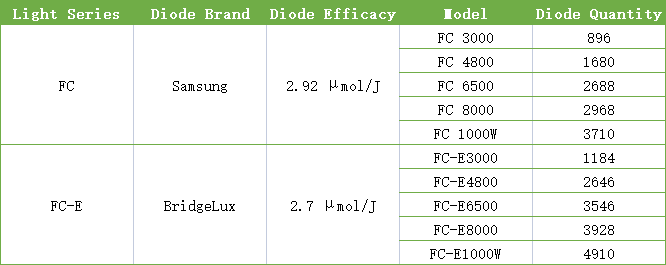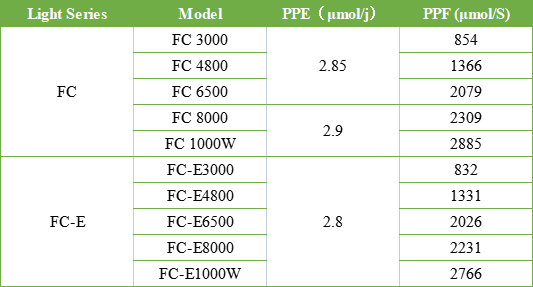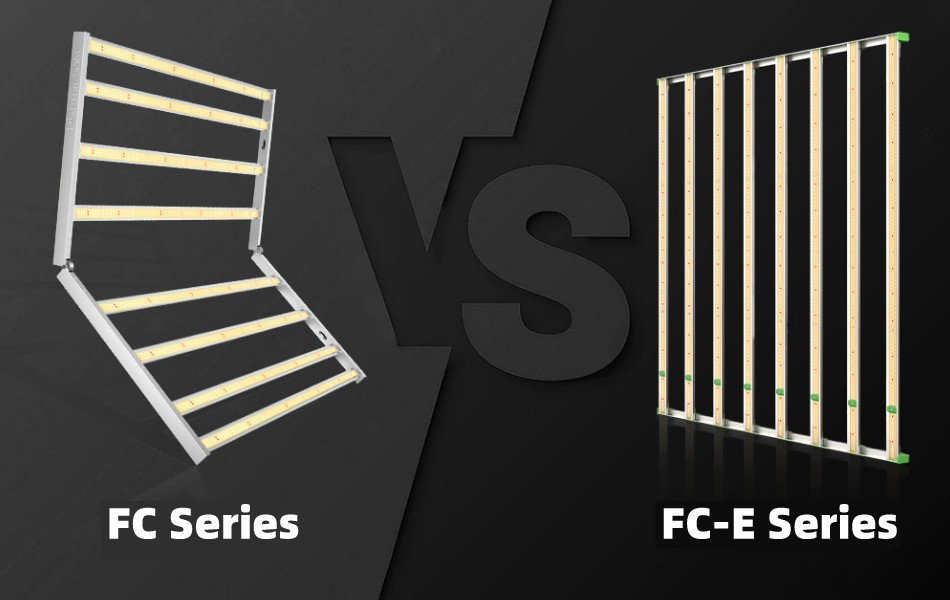After the release of the new FC-E series, many customers feel confused about how to choose between the FC series and FC-E series. They have similar names and similar appearances, but their prices are quite different.
In this blog, we’re going to explain their similarities and differences.
FC series includes: FC 3000, FC 4800, FC 6500, FC 8000, FC1000W
FC-E series includes: FC-E 3000, FC-E 4800, FC-E 6500, FC-E8000, FC-E1000W

![]() However, there’s still a small gap in whole-light efficiency between the FC-E and FC series. See the comparison of PPE/PPFD below.
However, there’s still a small gap in whole-light efficiency between the FC-E and FC series. See the comparison of PPE/PPFD below.

![]() FC series has higher efficacy than the FC-E series, but their gap is small – which means they will have similar grow results with one light.
FC series has higher efficacy than the FC-E series, but their gap is small – which means they will have similar grow results with one light.
![]()
![]() The major reason for this price gap is that Samsung diodes are a lot more expensive than any other diode in the market. As a result, when you find a grow light mounted with Samsung diodes is very cheap, it must be a fake or use an inferior diode model which is much less efficient than the 3030 series. (Lm301B series)
The major reason for this price gap is that Samsung diodes are a lot more expensive than any other diode in the market. As a result, when you find a grow light mounted with Samsung diodes is very cheap, it must be a fake or use an inferior diode model which is much less efficient than the 3030 series. (Lm301B series)
Similarities between the FC series and FC-E series
To clearly understand their differences, we must first know their similarities. FC series and FC-E series have 7 similarities. ·Appearance. They are both multi-bar style LEDs, covering a square area. ·Power Supply. FC series and FC-E series are both mounted with Mars Hydro drivers. ·Spectrum. They have the same spectrum design. 650-665nm, 2800-3000K, 4800-5000K ·Heat dissipation performance. They have the same heat sink design – A peak-shaped aluminum heat sink on each light bar to increase the heat dissipation area. So if you ask which is cooler. We would say they have little difference in this aspect. But the FC-E series will generate more heat because they have more chips (diodes). ·Uniformity. Due to their multi-bar style appearance, both series have an even light distribution. And, because the chips and bars are specially arranged, they have a more uniform light distribution than other LEDs. ·Daisy-chain Dimming Function. FC series and FC-E series both have a daisy chain function and dimming function. ·Waterproof. They both have an IP65 waterproof rating.Differences between the FC series and FC-E series
After we find all their similarities, now it’s time for their differences. They have 5 main differences.- LED Chips/Diodes
- PPE/PPFD
- FunctionalDesign
- Price
- Applications
Difference One: LED Chips/Diodes
The biggest difference between the FC series and the FC-E series is the LED diode mounted. FC series mounts Samsung diodes FC-E series mounts BridgeLux diodes These two brands are known in the industry. Samsung is well-known as a leading diode manufacturer; BridgeLux is a local American manufacturer with 18 years of experience. There’s nothing much to say about the history. They’re both reliable manufacturers. If you are interested, you can check their official website for information. What we growers are concerned about is their contribution to indoor growing. FC series use Samsung LM301B diodes, and the diode official efficacy data: 2.92 μmol/J FC-E series use BridgeLux 2835 series, and the diode tested efficacy data: 2.7μmol/J In terms of efficacy, Samsung is the winner. Therefore, to ensure the whole-light efficiency of the FC-E series, we use more diodes on it. You can clearly see this in the below table.
Difference Two: PPE/PPFD
It is most accurate to measure the efficiency of a grow light by PPE or PPFD. Let’s review their definitions: PPFD– Photosynthetic Photon Flux Density (PPFD) is the measurement of PAR delivered to a specific area. It is expressed as micro-mole-per-meter squared-per second (µmol/s/m2). PPE– Photosynthetic Photon Efficacy describes how much light a grow light produces from its input power. The metric used to measure PPE is micro-moles per second per Watt -which simplifies to µmol/J. Approximate Calculation: PPE x Wattage = PPFD (Though they’re super different) The PPE & PPF data of the FC series and FC-E series are shown in the table below:
Difference 3: Functional Design
Despite their similar appearance, their body design carries two different functions. FC series(4800 & 6500) is foldable. The light body itself can be folded in half. This design avoids the inconvenience of transporting and storing the huge light body, and the ability to fold freely at 180° allows the light itself to be bent to an angle to focus light on the central area – reducing coverage area for more light in the center. FC-E series are built with detachable light bars. This makes transportation and storage more convenient and the moveable light bars also provide growers with a more flexible, unique space to make their own lighting system. For example, unique design central and side lighting using FC-E4800 and SP3000. P.S. FC6500 is 8-bar light, and FC-E6500 is 6-bar light, though they’re both 730W grow lights.Difference 4: Price Difference
Apparently, these two series have a huge gap in price – that’s the main reason customers want to know their differences.Difference 5: Applications
Our comparison above is clear. For practical applications, PPE (or PPFD) & body design & prices are the major differences that may have an impact when using. A 0.1 µmol/J PPE gap between the FC series and FC-E series won’t make much difference in personal cultivation. But when it is applied to large commercial cultivation, a 0.1 difference is able to create thousands of dollars margin. Of course, if you’re an individual grower seeking top yields, the FC series will be your best choice. The detachable-bar design might be a small surprise for individual growers to enjoy the DIY time, while it is tough work for commercial growers because you will need to install hundreds of bars after receiving the lights. Consequently, the FC series and the FC-E series have different applicability. FC Series: Top yield, the top quality required; for any grow size/scale. FC-E Series: High yield, the high quality required; for individual grower scale or small commercial scale; for people with a limited budget. On top of that, FC8000, FC-E8000, FC 1000W, and FC-E1000W should be used in cultivations that apply CO2 (carbon dioxide) to increase their yields. Their light intensity is too high for general grow to absorb or bear.Finally
Hope this blog can help you know more about Mars HydroFC led grow light series andFC-E led grow light series. And help you find your own grow light. If you want to see more differences between FC6500 and FC8000, or FC-E6500 and FC-E8000, welcome to check out our new blog “Model Battle: 6500 vs. 8000”. Or if you want to know more clearly. just CONTACT US directly. We’d love to answer any questions.


